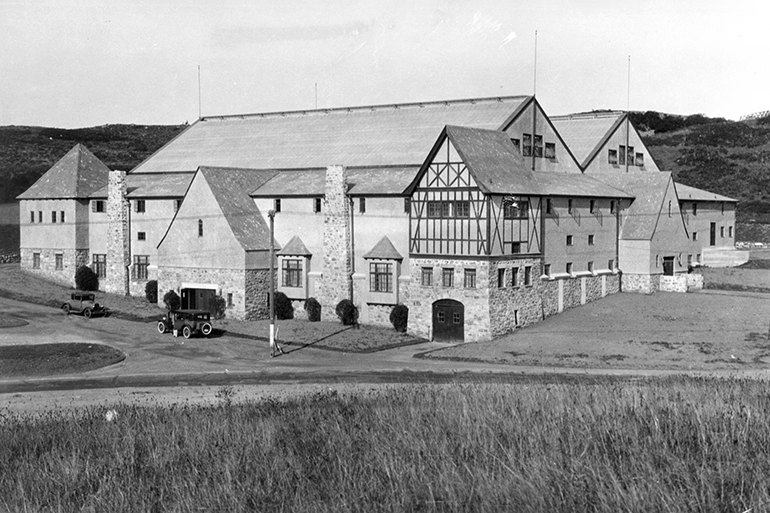Montauk Playhouse: Community Center, Tennis, Livestock and Broadway

The largest community center on the East End by far is the 26,000 square-foot facility in Montauk, across from the railroad station. Inside are a community gym, a senior citizen center, a daycare center and a town clerk’s office. These facilities only take up half of the space in the building. Still in the planning stages are a 30 x 30 swimming pool, a lap pool and 250-seat cultural arts center.
In December, someone anonymously donated $1 million to help finish the job, the largest single gift so far. The total cost is expected to be $11 million, with an additional $2 million needed for sustaining programming. So far, they’ve raised $7.5 million. This is a major gift.

This is pretty ambitious for a community that numbers less than 2,000 people. But Montaukers think big.
This building lay abandoned for nearly 40 years before the owner of it gifted it to the community in the 1990s. It has a remarkable history.
It was originally built in 1927 by developer Carl Fisher, who between 1926 and 1929 was transforming this wild area into a summer resort. The 1929 crash did him in. But in those years, he built the Montauk Manor, the skyscraper on the Plaza and the whole grid of streets downtown. He put two rows of stores facing each other on Main Street, which got the town started. He also built the Yacht Club, the Montauk Downs Golf Course, the two churches and a giant boardwalk and surf club, since torn down.
The 26,000-square-foot building that is now the community center he originally built as a grouping of four indoor tennis courts with a glass-enclosed roof and stadium seats for people to sit at to watch tennis matches. It was part of the Montauk Manor complex.
After Fisher went broke, this tennis court building became abandoned for 10 years. But in 1940 it was taken over by the U.S. Army, which also took over many of the other Fisher buildings. They kept supplies in the building, but they also installed a boxing ring. Prize fights were held there from 1941 to 1945, when the war ended.
After the Army left, the building found use in the fall as a holding pen for the cattle raised out at Deep Hollow Ranch, which, annually, got driven to the railroad station to be put aboard freight trains for transit to slaughter houses in the city.
Those cattle drives continued until 1955, when the railroad discontinued that service. After that, the cattle were herded aboard trucks at the ranch itself for transit to New York.

In 1958, the building was reborn as the Montauk Playhouse, a theater for summer stock. Broadway shows were performed there, among them The Boy Friend and South Pacific. Capacity was about 300, the audience seated on canvas folding Captain’s chairs.
After two years, the live shows ceased and the Montauk Playhouse became a movie theater. It remained as that until around 1968, when the Montauk Manor next door shut down. So once again, it was abandoned.
Another developer bought the property and tried to get plans approved by the Town, but they never went through. Instead, it continued abandoned, now with the developer walking away and donating it to the Town for the ceremonial $1. This was in the late 1970s.
In the 1980s, the Town decided this abandoned building should be torn down. The wreckers came in to examine the building and bid on the project, but the cost of was deemed so expensive as to be not worth it. Some of the stone walls of this building are four feet thick.
Finally, it has emerged as the Montauk Community Center, its official name THE MONTAUK PLAYHOUSE on a sign out front.
Interestingly, around the year 2000, those cleaning out this building in preparation for its becoming the community center, found storage boxes from merchants in the town. It had been the town’s unofficial attic during its abandoned years. One day, at my office in Bridgehampton, I received a manila envelope of cancelled checks my mother had written in the 1960s to suppliers such as clothing wholesalers and appliance manufacturers. We owned White’s Montauk Pharmacy back then—the store that has everything—and my mom had handed the books. I thanked those who sent it. Said they could dispose of the rest.




